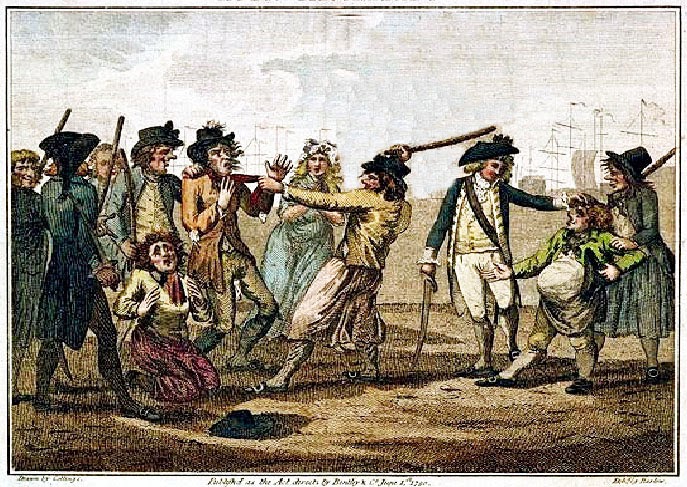Its weathered memorials standing just a stone's throw from the very edge of the quarry, are unusually elaborate and evocative.
In the present day and age, when atrocities take place far from home one particular memorial bears witness to a violent sequence of events that took place here on Portland over 200 years ago which ended in the violent death of twenty one year old Mary Way.
Her gravestone tells of her death as a result of wounds sustained after being shot by the Press Gang. The incident took place April 2 1803, and is remembered to this day as the Easton Massacre.
It all began on the night before her death when men from the Frigate, Eagle, had come ashore and unsuccessfully attempted to press Nicholas Way. He was the captain of a small vessel and therefore exempt from the press (as indeed all the able bodied men on the island were).
Undeterred, at 5.00 am the next morning the Eagle's captain landed at Easton with a heavily armed force of some thirty men and officers. The early hour was chosen to catch the islanders while they slept. One of the first men they apprehended was their previous night’s victim, Nicholas Way along with Henry Wiggat. By this time the villagers, woken by the furore, ran for cover in panic. As the Press Gang chased the villagers uphill they found their way was bravely blocked by Zachariah White. Demanding the source of their authority he discovered that the warrant, signed by a Mayor of Weymouth, had no legal authority on the island.
Undeterred, at 5.00 am the next morning the Eagle's captain landed at Easton with a heavily armed force of some thirty men and officers. The early hour was chosen to catch the islanders while they slept. One of the first men they apprehended was their previous night’s victim, Nicholas Way along with Henry Wiggat. By this time the villagers, woken by the furore, ran for cover in panic. As the Press Gang chased the villagers uphill they found their way was bravely blocked by Zachariah White. Demanding the source of their authority he discovered that the warrant, signed by a Mayor of Weymouth, had no legal authority on the island.
The sailors, though, ignored his protestations and moved on.
As the situation began to grow ugly they formed a defensive line. When they attempted to snatch yet another islander, the crowd snapped. In the ensuing scuffles a pistol, whether accidentally or not, was fired by the captain. This was the prearranged signal to open fire. In the ensuing chaos three islanders died instantly, shot through the head. Two more, one of them Mary Way, fell fatally wounded to the ground, a bullet lodged in her back. The pressgang who had also sustained casualties then retired to their ship taking their hard-won captives.
As the situation began to grow ugly they formed a defensive line. When they attempted to snatch yet another islander, the crowd snapped. In the ensuing scuffles a pistol, whether accidentally or not, was fired by the captain. This was the prearranged signal to open fire. In the ensuing chaos three islanders died instantly, shot through the head. Two more, one of them Mary Way, fell fatally wounded to the ground, a bullet lodged in her back. The pressgang who had also sustained casualties then retired to their ship taking their hard-won captives.
 |
| St Georges stands on the very edge of a quarry |
A short walk to the church
St Georges can be made the destination of a short but rewarding walk. The headstone of Mary Way is here, as is the doubly unfortunate William Hansford who died in the Great Storm of November 1824 when the sea came over the Chesil Beach and broke his leg after which his house fell on him and killed him.
Parking in Chiswell follow the signs for the coast path which takes you steeply uphill giving you breathtaking views of Chesil Bank and the Jurassic Coast. As the path levels out a diversion to the left will take you into the Tout Quarry Sculpture Park where sculptures lie amid the undergrowth like the relics of a lost civilisation. Continue along the path to reach the church.
There and back is just over 3 miles.








Great blog post. Gary Biltcliffe has also discovered some interesting things about this church and the history of Portland - see https://www.facebook.com/rovingpress. Love your blog and thanks again.
ReplyDeleteThanks I'll look with interest! ...and thanks for the feedback! Ian
Delete